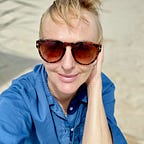The Wild Horses of Kleinmond.
In the Overberg town of Kleinmond roams a herd of feral horses. These majestic beasts live a life of freedom, their dark manes flowing in the wind.
My story on The Wild Horses of Kleinmond, as it appears in The Big Issue this month.
It’s a rather wet afternoon when we drive down the gravel road that leads to the Rooisand Nature Reserve past tall trees on the left and green fallow land to the right. Ours is the only car in the parking area, and on arrival, Dad and I zip up our jackets and pull on woollen hats to ward off the cold, before making our way to the elevated boardwalk that leads deeper into the wetlands reserve.
This has become a ritual for us in my ongoing quest to find the somewhat mythical wild horses of Kleinmond. I’m beginning to believe that I’m jinxed and will never be lucky enough to lay eyes on the elusive equines that live on this protected land.
Determined not to give up, we take up position in the wooden bird hide (which is situated at the end of the boardwalk on the western shore of the estuary), to wait and watch in hope.
It is my lucky day. We hear them before we see them. A swish of tails and low rumbling grunts, they come into sight through the narrow slat of the wooden hut. Unaware of our presence yet just metres away, a posse of thick-coated, wild horses wade belly-deep through the water, the mare leading the way; next to her a young foal follows.
My heart races at the sight of them, the privilege of witnessing what has become an anomaly in a world where man and beast fight for space and man mostly wins. Yet here, just a short drive from Kleinmond, this group of wild horses are masters of their own coastal kingdom and my patience has been richly rewarded with an excellent sighting.
Although this herd of about 28 horses is referred to as ‘wild’, they are in fact feral, and there is a difference. ‘Feral’ describes domestic animals that have successfully adapted to the environment and no longer rely upon humans, while ‘wild’ describes creatures that have never been subjected to domestication. That said, to local Overberg residents such as my parents, they will always be affectionately known as ‘the wild horses of Kleinmond’
According to Professor Frans van der Merwe, who has studied them for four decades, the origin of the herd can be traced back to the Delport family — early Overberg farmers whose land stretched from Ysterklip on the road to Bot River, all the way to the Kleinmond boundary.
At the time, the family were well- known breeders of horses and mules, and when mechanisation rendered farm horses obsolete at the turn of last century, they were forced to sell off most of their stock, except for a small group that was eventually abandoned in the Kleinmond marshes.
Other theories remain about their origins, however. Some say the horses swam to shore when the ship, The Birkenhead, sank in the nearby ocean. Others believe they are descendants of horses hidden in the area during the Anglo-Boer War. No matter their origins, they have adapted remarkably well and survived several generations. Although the remains of stillborn foals have been found over the years, the little herd was on the increase and there were 13 horses in 2001. The gene pool was supplemented in the late 1970s by a stallion belonging to the Boonzaaier family, boosting the population.
According to Professor van der Merwe, the horses are descendants of the once popular Boland waperd or wagon horse, a breed of Cape horse that has its origins in the renowned Basuto ponies of Lesotho. Hardy stock, and in essence remnants of a breed that is otherwise extinct.
They could not have chosen a more beautiful environment, and are a natural asset to the Rooisand Nature Reserve area. Free from human intervention, they have braved the elements here for generations. During the winter months, the horses grow a thicker hair that shields them against the icy wind and rain. Their hooves have evolved to become saucer-shaped and they have adapted to the soft, wet underfoot conditions. The stallions are said to fight often and fiercely amongst themselves, as evidenced by the battle scars that cover some of their flanks.
Importantly, their presence has no negative impact on the environment, and they have come to play an important role in nature by keeping paths through dense vegetation open, especially through reed beds, which is beneficial to other wildlife. Essentially, they are fulfilling the role that large wild herbivores once played in this environment before being annihilated by early colonists and hunters.
Although these horses are wild at heart, they are often curious about people. Human interaction should be kept at a minimum, however, and even though some horses have a tendency to walk straight up to you or follow you closely, touching is discouraged. Do not try and feed them or take them treats, there is ample grazing, including the succulent water grasses and green shoots, despite the region’s veld suffering occasional fires.
Originally published at theincidentaltourist.com on February 20, 2019.
